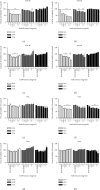Sonicated Extract from the Aril of Momordica Cochinchinensis Inhibits Cell Proliferation and Migration in Aggressive Prostate Cancer Cells
- PMID: 36605288
- PMCID: PMC9810401
- DOI: 10.1155/2022/1149856
Sonicated Extract from the Aril of Momordica Cochinchinensis Inhibits Cell Proliferation and Migration in Aggressive Prostate Cancer Cells
Abstract
Momordica cochinchinensis or gac fruit has been reported to have several biological activities, including antioxidation, anti-inflammatory, and anticancer activities. However, the effect on cancer cell metastasis has not been extensively studied. With this aim, the extract from the aril part was selected and investigated for prostate cancer cell migration. The aril extracts were prepared as boiled extract, sonicated extract, ethanol extract, and HAE (hexane:acetone:ethanol; 2 : 1 : 1) extract, while the prostate cancer cell models were PC-3 and LNCaP cells. An MTT assay was performed to compare the antiproliferative effect between prostate cancer cells and normal Vero cells. As a result, the sonicated extract had the highest efficiency in PC-3 cells, with IC50 values of 2 mg/mL and 0.59 mg/mL for 48 and 72 h, respectively, while it had less of an effect in LNCaP cells and was not toxic to normal cells. Cell damage was further confirmed using LDH and cell cycle analysis. As a result, the sonicated extract did not cause cell damage or death and only inhibited cell proliferation. The effect on cancer metastasis was further examined by wound healing, transwell migration assays, and western blotting. The results demonstrated that the sonicated extract inhibited PC-3 cell migration and decreased MMP-9 but increased TIMP-1 expression. All these results support that gac fruit is a valuable source for further development as an anticancer agent for prostate cancer patients.
Copyright © 2022 Seksom Chainumnim et al.
Conflict of interest statement
The authors declare that they have no conflicts of interest.
Figures






References
LinkOut - more resources
Full Text Sources
Research Materials
Miscellaneous

